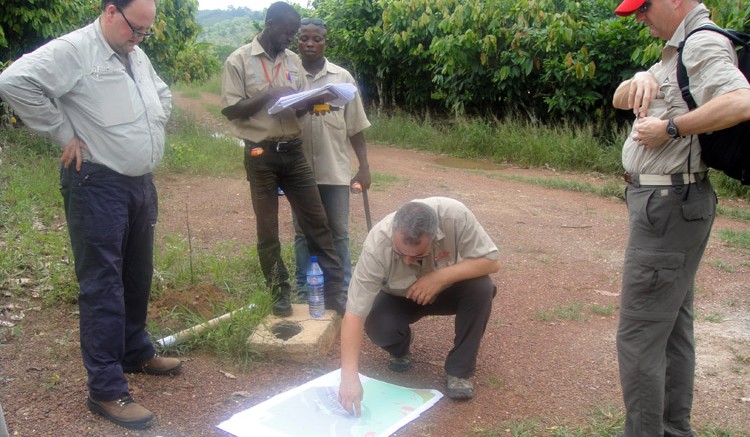VANCOUVER — Eight months ago junior Edgewater Exploration (TSXV: EDW) was hit with a permitting delay at its flagship Corcoesto gold project 35 km due southwest of the port city of La Coruna in Spain. Edgewater had been hoping to fast track Corcoesto into production, but the regional government of Galicia quashed that idea when it applied additional financial and scoping stipulations to the company’s permits.
The move put Edgewater in a tough position financially since equity markets have been weak and one of the government’s key conditions wasthe company securing US$40 million in project funding. So Edgewater started cost-cutting to preserve its capital as negotiations continue with the government and potential joint-venture partners, while its Enchi gold asset in Ghana, West Africa — around 290 km west of the capital of Accra — sat relatively idle.
Edgewater had been advancing its 51% interest in Enchi under a joint-venture agreement with producer Kinross Gold (TSX: K; NYSE: KGC) it signed back in 2010. Kinross had picked up the project in its US$7.1-billion acquisition of Lukas Lundin’s Red Back Mining earlier that year.
On May 22 Edgewater revealed it would be acquiring Kinross’ outstanding 49% interest in Enchi and moving it into a new vehicle to realize maximum value from the asset, even as the company continues to navigate its policy issue in Spain.
“Simply put we’d been doing a lot of exploration in West Africa for years, and for years we weren’t getting a lot of love for the story,” comments Edgewater president and CEO George Salamis during an interview, noting that Edgewater has invested nearly US$8 million at Enchi since 2010.
“And I think that’s primarily due to the joint-venture structure with Kinross. Investors would say to us ‘come back when you can consolidate the ownership of the project,’ and that’s what we’ve done. The other reason is we can fund it separately and it separates us from Edgewater’s activities in Spain,” he adds.
Salamis will also assume CEO duties at Enchi’s new home — namely Pinecrest Resources (TSXV: PCR), which is a shell company with limited outstanding shares. Under terms of the agreement Pinecrest will acquire Kinross’ 49% stake in Enchi for around a 20% equity stake, along with a 2% net smelter returns royalty (NSR) and US$10 per oz. of any newly-compliant measured-and-indicated gold resources. Kinross also maintains a right of first refusal to process Enchi’s ore at its nearby Chirano mill.
Meanwhile, Edgewater shareholders will receive one share of Pinecrest for every five shares held. The end result will see Edgewater shareholders with around a 40% equity interest in Pinecrest. In addition Pinecrest is obligated to complete a non-brokered private placement of 15 million subscription receipts at a price of 20¢ each for gross proceeds of $3 million, and pay Edgewater $150,000 in cash.
“Another thing is the recent push into low-cost, heap-leach operations we’re seeing in West Africa,” Salamis continues. “Assets like True Gold Mining‘s (TSXV: TGM) Karma project and similar stories have moved us down this track. Over the course of our exploration we were always looking for that ‘monster gold’ deposit in Western Ghana similar to what Kinross has at Chirano. Along the way we started hitting a lot of gold in the saprolite, and that ended up being the basis of the resource.”
Enchi includes around 560 sq. km over ten licenses that cover 50 km of strike length along the Bibiana Shear zone, which also hosts Kinross’ Chirano operation. Extensive faulting — on local and regional scales — occurs along the margins of volcanic-sedimentary belts, with these northeast-trending structures being fundamentally important in the development of the mesothermal-quartz vein style gold deposits in the region.
“It’s important to look at the large strike extension we have the concession. I mean, we have a dozen promising intercepts that we really need to follow up on moving forward,” Salamis adds. “Enchi could become a lot bigger, but we want to initially prove up a cost-efficient start-up operation that focuses on those heap-leach ounces. We’ve identified over ten new targets based on soil sampling and geophysics.”
On May 12 Edgewater released an update resource estimate at Enchi that focuses on near-surface mineralization that extends to an average vertical depth of roughly 75 metres, and remains open along strike and at depth. The company has been focusing on gold hosted within oxidized-saprolitic rock along several kilometres of prospective strike. The updated resource includes 52,400 metres of drilling across three zones — namely Boin, Nyam, and Sewum — and outlines 21 million inferred tonnes grading 1.15 grams gold per tonne for 768,000 contained oz. at 0.7 gram gold cut-off grade.
“The focus is really on the cash we will raise. It’s going to focus on advancing and realizing value at Enchi, which I think hasn’t exactly been something that’s been achieved over the past few years in the precious metal space,” says incoming Pinecrest president Ryan King. “Many investors have exited the space completely, but we think we have enough resources in the ground that we can spend a reasonably small amount of capital to demonstrate the positive aspects of the project and drive that value.”
King adds that Pinecrest sees the potential for a “low capital, heap-leach operation” that could produce between 40,000 oz. and 60,000 oz. of gold per year. The company will immediately earmark around $500,000 to complete a preliminary economic assessment (PEA) on the project, with a major focus on refining metallurgical work.
Edgewater has traded within a 52-week window of 4¢ and 25¢, and closed up 33% at 8¢ per share at the time of writing. The company maintains 105 million shares outstanding for an $8.4 million press-time market capitalization. Pinecrest remained under a trading halt following the restructuring news, and maintains 23 million shares outstanding for a $1.3 million market capitalization.


Be the first to comment on "[Update] Edgewater moves to consolidate Enchi project"